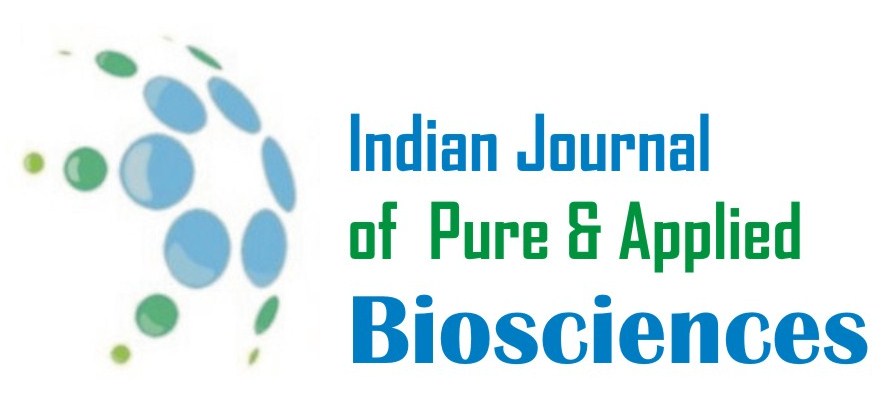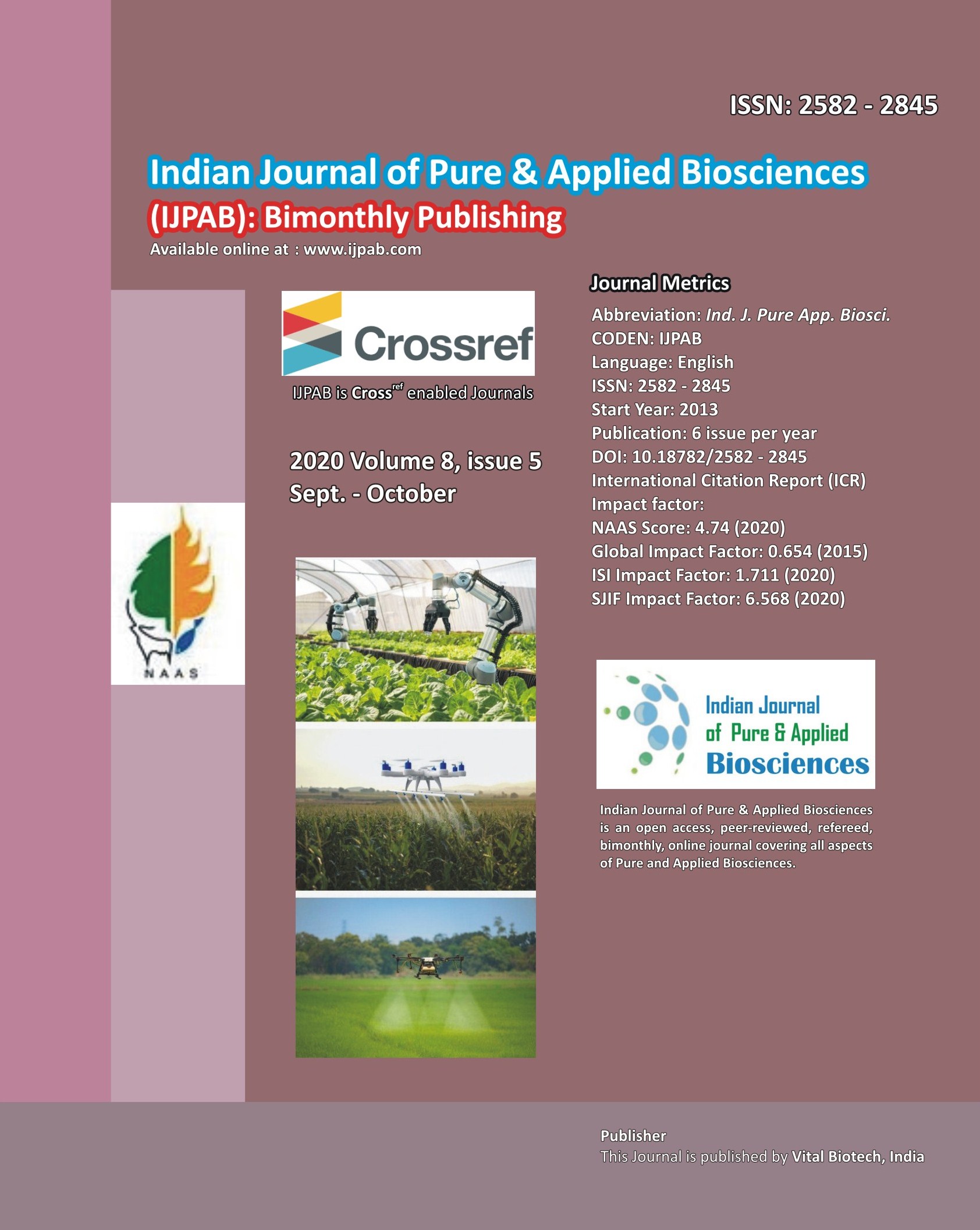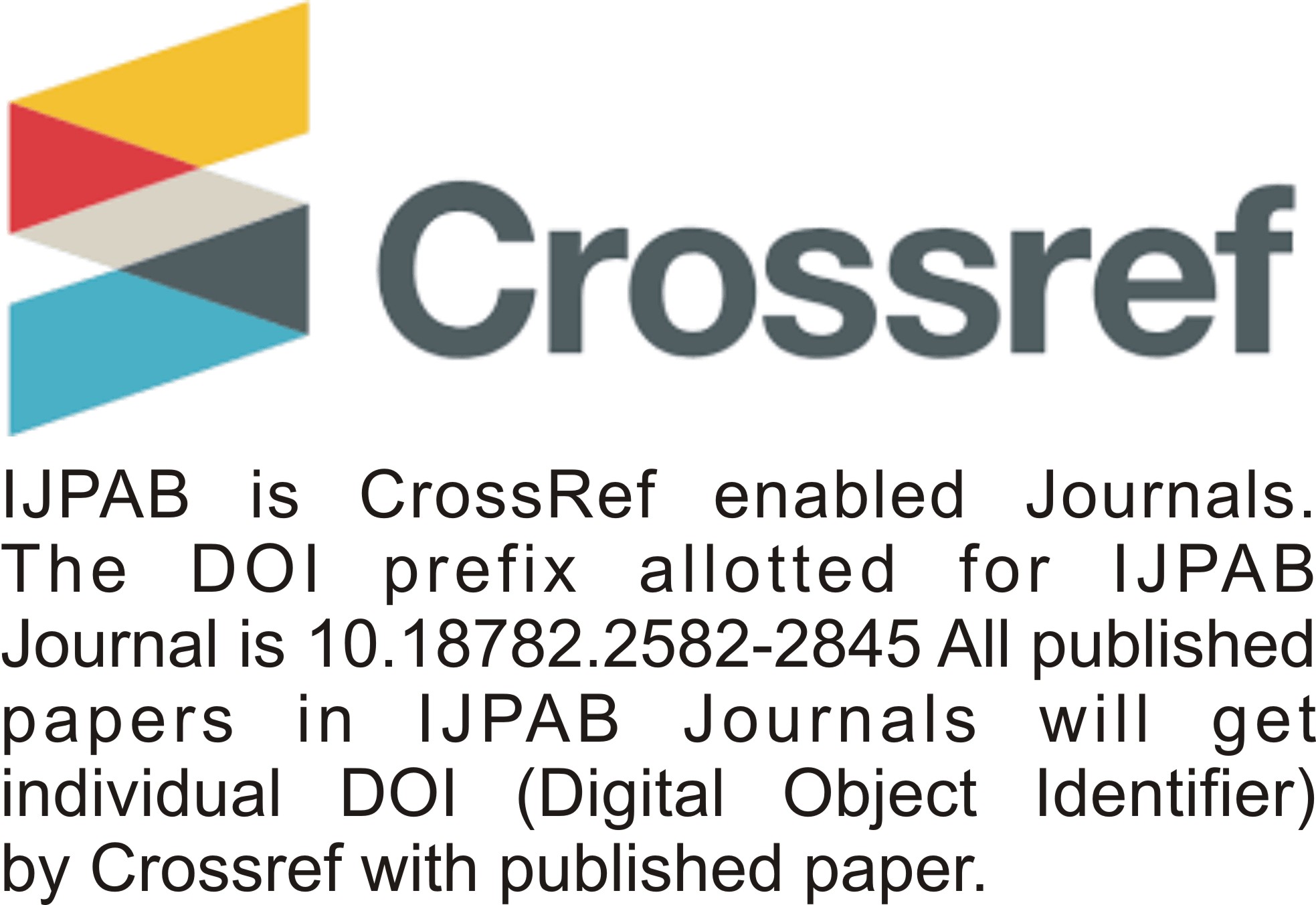
-
No. 772, Basant Vihar, Kota
Rajasthan-324009 India
-
Call Us On
+91 9784677044
-
Mail Us @
editor@ijpab.com
Indian Journal of Pure & Applied Biosciences (IJPAB)
Year : 2020, Volume : 8, Issue : 5
First page : (519) Last page : (523)
Article doi: : http://dx.doi.org/10.18782/2582-2845.8404
Knowledge of Farm Women on Nutritional Value of Farm Products in Pali district of Rajasthan
Aishwarya Dudi* ![]() and Dheeraj Singh
and Dheeraj Singh
ICAR-CAZRI, Krishi Vigyan Kendra, Pali (Rajasthan) India 306401
*Corresponding Author E-mail: aishwaryadudi@rediffmail.com
Received: 5.09.2020 | Revised: 12.10.2020 | Accepted: 19.10.2020
ABSTRACT
The present study objective was to determine the extent of knowledge of farm women on nutritional value of farm products. A sample of 120 respondents was selected from three selected villages under Pali district of Rajasthan following the proportionate random sampling technique. Data were collected using interview schedule. Simple statistics like number, mean, range, percentile and standard deviation were used. Pearson’s coefficient of correlation was employed to explore relationships between nutritional knowledge of farm women and their selected characteristics. Findings revealed that highest proportion of the respondent (65%) possessed poor knowledge on nutritional value of farm products. Age showed negative significant and education and training experience showed positive significant relationship with knowledge level of the farm women.
Keywords: Health, Knowledge, nutrition, Farm products and Farm women.
Full Text : PDF; Journal doi : http://dx.doi.org/10.18782
Cite this article: Dudi, A., & Singh, D. (2020). Knowledge of Farm Women on Nutritional Value of Farm Products in Pali district of Rajasthan, Ind. J. Pure App. Biosci. 8(5), 519-523. doi: http://dx.doi.org/10.18782/2582-2845.8404
INTRODUCTION
ealth of women is directly related to the well being of the entire family. The literature indicates that rural women face higher risks of morbidity and mortality because of strenuous physical work (Rawat, 1995). India's food and nutrition problems continue to be formidable and malnutrition is still one of the crucial problem in the process of development. Nearly two-thirds of India's population is on a nutritionally deficient diet. This is mainly due to lack of knowledge of the value of foods in relation to the needs of the individual. Ignorance and superstitions play a great role in the rejection of low cost, locally available nutritious foods. Rural women are key agents for achieving the transformational economic, environmental and social changes required for sustainable development (Golmohammadi & Honari, 2016). Rural women are responsible for half of the world’s food production and produces between 60-80 per cent of the food in most developing countries (Narain, & Gupta & Singh, 2015). This is particularly so when women farmers are able to make decisions regarding the cropping pattern and choose ‘what to grow and what to retain for the household’.
Women are important drivers of change in stimulating production and consumption diversity in rural populations. Women tend to value household nutrition more than men and are the primary decision makers on consumption diversity (Rukmani et al., 2019). The women affected by malnutrition suffer from deficiencies of different nutrients. They also have poor physical as well as mental growth and development which cause various handicaps. Nutritional knowledge has great importance in proper management of food, application of balance diet and specific requirements of different nutrients for people of different age groups. If women have optimum knowledge regarding that then they can fulfill nutrition of them and their family and only then food security of their family can be achieved. They can also save their family easily from malnutrition problem. Woman can play an important role in selection, preparation and serving of food for their family members (Kumari, & Srivastava & Sinha, 2010). It is therefore, necessary to determine the extent of knowledge of the farm women on nutritional value of farm products; and to identify the relationship between the extent of knowledge of the farm women and their selected socio-demographic characteristics.
MATERIALS AND METHODS
Study has been conducted in three adopted villages of Krishi Vigyan Kendra, CAZRI, Pali (Rajasthan) namely Bomadra, Kharda and Uttwan. Women involved with the farming activities of the selected three villages was the target population of the study. An updated list of 360 farm households was prepared with the help of villagers from three selected villages. From them 120 respondents were selected as a sample by using proportionate random sampling technique. Data were collected using interview schedule personally by the researchers through face to face interview. Simple statistics like frequency, percentage, range, mean, standard deviation and rank order were used in the interpretation of descriptive data. Coefficients of correlation were used to find out the relationship among the variables. Selected characteristics of the respondent such as age, education, size of family, annual income, training experience, contact with sources of information and organizational participation were considered as the independent variables of the study. Knowledge of farm women on nutrition and food security was the dependent variables of the study and was measured by asking twenty selected questions on different aspects of nutritional value of farm products. The null hypothesis is formulated in this specific research was: “There is no significant relationship between selected characteristics of farm women with their extent of knowledge on nutritional value of farm products”.
RESULTS AND DISCUSSION
Knowledge of farm women about nutrition
Knowledge about nutrition of a respondent was measured by some selected questions regarding different aspects of nutritional value of farm products. Data presented in Table 1 reveals that the highest score obtained by the respondents was 32 and lowest was 10 with a range of 22 and coefficient of range 0.524. Standard deviation of knowledge was 2.36 and co-efficient of variation was 14.09 per cent. Knowledge was categorized into three categories i.e. high, medium and low on the basis of standard deviation.
Perusal of Table 2 shows that majority of the respondents (65%) had low knowledge while 28.33 per cent had medium level of knowledge and only 6.67 per cent respondents had high level of knowledge. The overall mean percent score of knowledge was found 32.50 (Jethi & Chandra, 2013).
Questions for measuring knowledge:
The respondents were asked to answer 20 selected questions on nutrition for measuring their knowledge level (Table 3). The questions consisted of different aspects of nutritional value of farm products. It is clearly shown that items how to get good quality of farm products during harvesting, protein enriched farm products from livestock and poultry and two plants of high medicinal values were answered correctly by majority of the respondents and ranked highest (81.67% ranked 1st, 80% ranked 2nd and 79.17% ranked 3rd, respectively). Further Table reveals that almost 70 per cent of the respondents answered correctly about importance of nuts in diet, right way of vegetable cooking, two energy rich sources and balanced diet and got rank 4th, 5th, 6th and 7th respectively. It is interesting to note that item two vitamin A enriched fruits and vegetable was not answered by any respondents. They were not heard about Vitamin A and its functions in human body. Items rickets in children, iodine deficiency disease, and functions of carbohydrate and protein in human body were answered correctly by less of the respondents (2.50%, 5%, and 10.83% respectively) and ranked bottom. It was clear from findings that farm women have not proper knowledge about basics of nutrition, type of nutrients and its role in human body. Most of the women had not knowledge about nutritive values of farm food produces.
Relationship between selected characteristics of the respondents and their extent of knowledge:
Table 1: Score range of knowledge and standard deviation
Range of knowledge |
Co-efficient of range |
Average scores |
Standard deviation |
Co-efficient of variation (%) |
10-32 (22) |
0.524 |
16.75 |
02.36 |
14.09 |
Table 2: Distribution of the respondents according to their knowledge
Categories |
Number (n) |
Percent (%) |
Overall mean per cent score |
Low (10 -14) |
78 |
65.00 |
32.50 |
Medium (15 - 19) |
34 |
28.33 |
|
High (20 - 32) |
08 |
06.67 |
Table 3: Rank order of the knowledge of the respondents on nutritional value of farm products
Questions |
Answered correct |
Rank |
|
Number (n) |
Per cent (%) |
||
What is balanced diet? |
84 |
70.00 |
7th |
Functions of carbohydrate and protein in human body |
60 |
50.00 |
9 th |
Sources of iron to prevent anemia |
34 |
28.33 |
12 th |
Name two diseases which are caused by vitamin-A deficiency |
18 |
15.00 |
15 th |
What are the protein enriched farm products that we get from livestock and poultry? |
96 |
80.00 |
2 nd |
Name two calcium rich food sources |
68 |
56.67 |
8 th |
How vegetables can be cooked without losing its nutrient value? |
91 |
75.83 |
5 th |
Name one for each of vitamin C enriched fruit and vegetables |
33 |
27.50 |
13 th |
Name two carbohydrate enriched farm products which mostly come from cereals |
42 |
35.00 |
11 th |
Why nuts (like peanuts, seeds) are important for good health |
93 |
77.50 |
4 th |
Name of two energy rich food source |
86 |
71.66 |
6 th |
What is the disease that causes for iodine deficiency? |
06 |
05.00 |
18 th |
What are the diseases that cause due to vitamin-C deficiency? |
15 |
12.50 |
16 th |
How do you ensure good quality of farm products during harvesting? |
98 |
81.67 |
1st |
How rickets can be reduced in children? |
03 |
02.50 |
19 th |
Mention two name of fruits that have high medicinal value |
95 |
79.17 |
3rd |
Mention the function of carbohydrate and protein in human health |
13 |
10.83 |
17 th |
Name of two vitamin A enriched fruits and vegetables |
0 |
0 |
20 th |
Why it is necessary to wash fruits and vegetables before cutting? |
56 |
46.67 |
10 th |
What are the nutrients that mostly come from fruits and vegetables? |
23 |
19.17 |
14 th |
Table 4: Relationship between selected characteristics of the respondents and their extent of knowledge
Personal attribute |
Correlation cofficient ‘r’ |
Age |
-0.358* |
Education |
0.283* |
Size of family |
0.254 NS |
Annual income |
0.117 NS |
Training experience |
0.367** |
Contact with source of information |
0.089 NS |
Organizational participation |
0.243 NS |
CONCLUSION
Majority of the respondents had low level of knowledge about nutritional value of farm products. Age had negative significant and education and training experience showed positive significant relationships with knowledge level of the farm women. The study points out the needs of nutrition education and intervention programmes for improving nutritional knowledge and behavioral change of tribal farm women.
REFERENCES
Golmohammadi, F., & Honari, Y. (2016). Rural women cooperative and its development impacts in Khorashad village, Birjand in South Khorasan Province - East of Iran, Indian Research Journal of Extension Education. 16(1), 61-67.
Jethi, R., & Chandra, N. (2013). Nutritional status of farm women in hills of Uttarakhand. Indian Research Journal of Extension Education. 13(3), 92-101.
Kumari, M. A., Srivastava, K., & Sinha, N. (2010). Extent of knowledge of farm women on nutrition, Indian Research Journal of Extension Education. 10(1), 65-68.
Narain, S., Gupta, S., & Singh, S. (2015). Status of women empowerment in agriculture: A Reality of Bundelkhand Region of Uttar Pradesh, Indian Research Journal of Extension Education. 15(4), 16-20.
Poshiya, V. K., Tiwari, M. V., & Khodifad, P. B. (2019) Knowledge of tribal farm women about human nutrition in Narmada district, International Journal of Recent Scientific Research. 10(7), 33779-33781.
Rawat, A. S. (1995). Deforestation and forest policy in the lesser himalayan Kumaon: Impacts on the peasant women and tribal population, Mountain Research and Development. 15(4), 311-322.
Rukmani, R., Gopinath, R., Anuradha, G., Sanjeev, R., & Yadav, V. K. (2019) Women as drives of change for nutrition sensitive agriculture: Case study of a novel extension approach in Wardha, India, Agricultural Research. 8, 523-530.
Suchitra & Kumar, R. (2018). Knowledge of Rural women regarding nutritional practices in Bikaner district of Rajasthan, India, International Journal of Current Microbiology and Applied Sciences. 7(2), 3174-3184.

